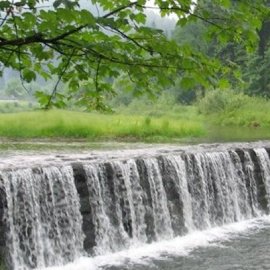Planning with Water, Part 6
-
English
-
ListenPause
I’m Peter Neill, Director of the World Ocean Observatory. In our last edition our ongoing series, Planning with Water, we discussed the collapse of the water system in São Paulo, Brazil, a city, and a nation, long thought to have inexhaustible water, faced with water rationing, expensive transfer by tanker or truck to meet the emergency need, inevitable social unrest, even anarchy, and a demand for accountability for the failure of an essential system to meet an essential need. Let me give you another, more positive example – the city of Olomouc, on the Morava River, capital of Moravia in the east of the Czech Republic. While dramatically smaller than São Paulo, with a regional population of 500,000, the city nonetheless evinces a comparable catalogue of critical symptoms: an old and outmoded water network, growing population, area expansion, urban renewal and reconstruction, public demand and expectation of service, and impact of the consequence of climate change, in localized but inevitable effect, on past weather patterns, industry and agriculture, and social behavior. What to do? To its credit, the municipal government commissioned the Danish Hydraulic Institute to do a complete analysis of the overall water system and its management plan to include its current demand and future needs to integrate and redevelop regional collection and distribution, connect elements such as the sewer network, storm water drainage, and watershed culverts and creeks, and provide a process for design and cost estimation of recommendations derived. Commissioned in 2012, the consultants produced a plan through the year 2030 by first mapping the regional drainage area; second, creating computer analyses and models to evaluate and simulate present and future conditions; and third, making recommendations for a reconstruction plan that prioritized the necessity of repairs and assessing the technical and financial aspects of future developments. DHI describes the scope of work as follows: evaluation of network conditions; solving existing variations in water supply pressure; examining combined sewer overflows and interrelation with flow protection measures; identification of flood risk zones; integration of infrastructure improvements in city investment plan; calibration of sewer and water supply models; analyzing and updating existing sewer and water supply systems; and setting guidelines and conditions for new municipal construction. In effect, using the most sophisticated mapping, data management, and modeling software, the consultants could provide a single comprehensive visualization of integrated existing conditions, indicate weakness and priority for repair and maintenance, model impact of changing future conditions, suggest resultant infrastructure improvements, and estimate costs for municipal investment over a twenty year period. Suddenly, unlike São Paulo, Olomouc had a plan. The challenge, of course, will be to apply it, finance it, and adapt it to the inevitable changing conditions the future will bring. The politics and the costs will be real and difficult no doubt, but the plan at least provides a responsible structure for a responsible governmental response to the need of the community to manage its most important socio-economic resource. Why do I belabor this example of a small inland city? Like São Paulo and many other cities around the world, Olomouc sits on a river somewhere in between the mountains and the sea. These habitations are both reality and symbol of the water connections and cycles on which we have and must depend. This water sustains the agriculture, industry, health, and myriad other social benefits of each place along the way, from upstream to downstream to the ocean and back again. The water provides, the watershed distributes, the ocean collects and circulates, and the cycle turns like history, like fate, like the circle of civilization. So let’s give a cheer to the good fathers of Olomouc! And let’s send our prayers to the good people of São Paulo who have not been so well served by their good fathers. And let’s understand the difference between complacency and foresight, between indifference and engagement, between denial and acceptance, between avoidance and active participation in the building of our future around water. Let’s go with the flow! We will discuss these issues, and more, in future editions of World Ocean Radio.
In the sixth and final installment of the "Planning with Water" series, host Peter Neill follows up on last week's episode in which he described the collapse of the water system in São Paulo, Brazil, a city long thought to have an inexhaustible water supply. In this episode he offers a positive example of a city in Moravia in the Czech Republic that is planning for a water system crisis before it's too late. The "Planning with Water" series looks toward building a new value premise and societal change around water as the most valuable commodity on earth, essential to our future survival.
About World Ocean Radio:
Peter Neill, Director of the World Ocean Observatory and host of World Ocean Radio, provides coverage of a broad spectrum of ocean issues from science and education to advocacy and exemplary projects. World Ocean Radio, a project of the World Ocean Observatory, is a weekly series of five-minute audio essays available for syndicated use at no cost by college and community radio stations worldwide. A selection of episodes is now available in Portuguese, Spanish, French, and Swahili. In 2015 we will add Mandarin to our roster of global languages, enabling us to reach 75% of the world's population. For more information, visit WorldOceanObservatory.org/world-ocean-radio-global.
Resources from this episode:
< The Danish Hydraulic Institute
< Water Management Plan of the city of Olomouc, Moravia | DHI Case Study
< Sao Paolo, Brazil: 2015 Water Crisis
< Mega Cities in Water Crisis
"Planning with Water" Series
< Part I
< Part II
< Part III
< Part IV
< Part V
- Login to post comments



